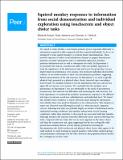Files in this item
Squirrel monkey responses to information from social demonstration and individual exploration using touchscreen and object choice tasks
Item metadata
| dc.contributor.author | Renner, Elizabeth | |
| dc.contributor.author | Atkinson, Mark | |
| dc.contributor.author | Caldwell, Christine A. | |
| dc.date.accessioned | 2020-11-02T10:30:09Z | |
| dc.date.available | 2020-11-02T10:30:09Z | |
| dc.date.issued | 2019-11-04 | |
| dc.identifier | 270943418 | |
| dc.identifier | 29449167-7253-4d5c-ab81-2e1c2d6d3e41 | |
| dc.identifier | 85075741782 | |
| dc.identifier.citation | Renner , E , Atkinson , M & Caldwell , C A 2019 , ' Squirrel monkey responses to information from social demonstration and individual exploration using touchscreen and object choice tasks ' , PeerJ , vol. 7 , e7960 . https://doi.org/10.7717/peerj.7960 | en |
| dc.identifier.issn | 2167-8359 | |
| dc.identifier.other | crossref: 10.7717/peerj.7960 | |
| dc.identifier.uri | https://hdl.handle.net/10023/20876 | |
| dc.description | This project has received funding from the European Research Council (ERC) under the European Union’s Horizon 2020 research and innovation programme under grant agreement number 648841 RATCHETCOG ERC-2014-CoG. | en |
| dc.description.abstract | We aimed to study whether a non-human primate species responded differently to information acquired socially compared with that acquired individually. To do so, we attempted to train squirrel monkeys to perform binary discriminations. These involved exposure to either social information (human or puppet demonstrator performs an initial ‘information trial’) or individual exploration (monkey performs information trial as well as subsequent test trials). In Experiment 1, we presented the task on a touchscreen tablet. Only one monkey appeared to learn the significance of the information trial, and across the group there was no improvement in performance over sessions. The proficient individual showed little evidence of successful transfer to three-way discrimination problems, suggesting limited representation of the task structure. In Experiment 2, we used a logically identical task, presented as a physical object choice (inverted cups concealing a food reward). No monkeys learned to use the information trial cues, and success again did not increase over sessions. We concluded that the monkeys’ poor performance in Experiment 1 was not attributable to the mode of presentation (touchscreen), but reflected real difficulties with mastering the task structure. For both experiments, we analysed the monkeys’ spontaneous responses to the different trial types (social-win, social-lose, individual-win, and individual-lose). We found that monkeys had a tendency to repeat selections made during the information trial, whether these were made by themselves or by a demonstrator. This tendency to repeat was observed even following lose trials (i.e. when incorrect). Apparent ‘success’ following win trials was probably largely an artefact of behavioural inertia (individual learning conditions) and stimulus enhancement (social learning conditions), rather than sensitivity to the reward cues associated with that stimulus. Although monkeys did respond somewhat differently (more repeats) following win trials, compared with lose trials, this was no more apparent in the object choice task than the touchscreen task, again suggesting that the less ecologically valid presentation medium did not actively disrupt potential for learning the discrimination rule. Both touchscreen and physical object choice tasks appear to be valid methods to study learning in squirrel monkeys, with neither method giving a clear performance advantage over the other. However, this population did not master the contingencies in these tasks. | |
| dc.format.extent | 28 | |
| dc.format.extent | 8560639 | |
| dc.language.iso | eng | |
| dc.relation.ispartof | PeerJ | en |
| dc.subject | Social learning | en |
| dc.subject | Individual learning | en |
| dc.subject | Primates | en |
| dc.subject | Touchscreen | en |
| dc.subject | Object-based tasks | en |
| dc.subject | BF Psychology | en |
| dc.subject | DAS | en |
| dc.subject.lcc | BF | en |
| dc.title | Squirrel monkey responses to information from social demonstration and individual exploration using touchscreen and object choice tasks | en |
| dc.type | Journal article | en |
| dc.contributor.institution | University of St Andrews. School of Management | en |
| dc.identifier.doi | 10.7717/peerj.7960 | |
| dc.description.status | Peer reviewed | en |
This item appears in the following Collection(s)
Items in the St Andrews Research Repository are protected by copyright, with all rights reserved, unless otherwise indicated.

